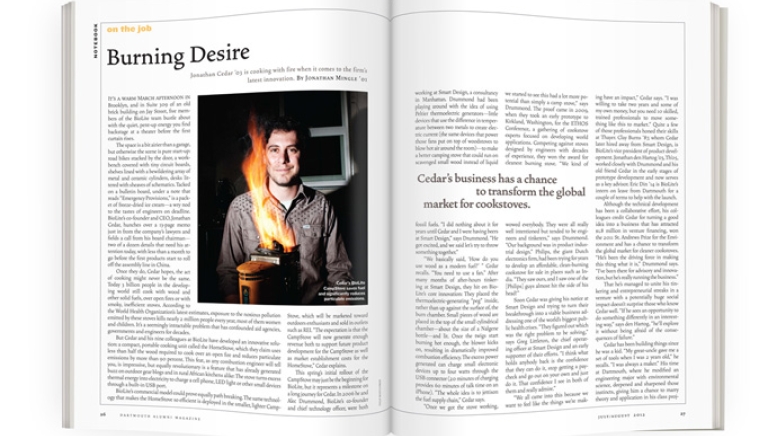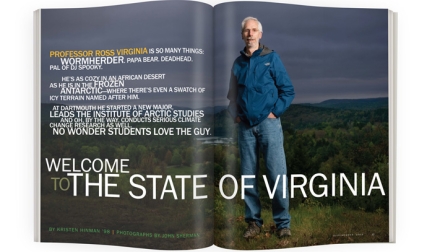It’s a warm March afternoon in Brooklyn, and in Suite 309 of an old brick building on Jay Street, five members of the BioLite team bustle about with the quiet, pent-up energy you find backstage at a theater before the first curtain rises.
The space is a bit airier than a garage, but otherwise the scene is pure start-up: road bikes stacked by the door, a workbench covered with tiny circuit boards, shelves lined with a bewildering array of metal and ceramic cylinders, desks littered with sheaves of schematics. Tacked on a bulletin board, under a note that reads “Emergency Provisions,” is a packet of freeze-dried ice cream—a wry nod to the tastes of engineers on deadline. BioLite’s co-founder and CEO, Jonathan Cedar, hunches over a 13-page memo just in from the company’s lawyers and fields a call from his board chairman—two of a dozen details that need his attention today, with less than a month to go before the first products start to roll off the assembly line in China.
Once they do, Cedar hopes, the act of cooking might never be the same. Today 3 billion people in the developing world still cook with wood and other solid fuels, over open fires or with smoky, inefficient stoves. According to the World Health Organization’s latest estimates, exposure to the noxious pollution emitted by these stoves kills nearly 2 million people every year, most of them women and children. It’s a seemingly intractable problem that has confounded aid agencies, governments and engineers for decades.
But Cedar and his nine colleagues at BioLite have developed an innovative solution: a compact, portable cooking unit called the HomeStove, which they claim uses less than half the wood required to cook over an open fire and reduces particulate emissions by more than 90 percent. This feat, as any combustion engineer will tell you, is impressive, but equally revolutionary is a feature that has already generated buzz on outdoor gear blogs and in rural African kitchens alike: The stove turns excess thermal energy into electricity to charge a cell phone, LED light or other small devices through a built-in USB port.
BioLite’s commercial model could prove equally path breaking. The same technology that makes the HomeStove so efficient is deployed in the smaller, lighter CampStove, which will be marketed toward outdoors enthusiasts and sold in outlets such as REI. “The expectation is that the CampStove will now generate enough revenue both to support future product development for the CampStove as well as market establishment costs for the HomeStove,” Cedar explains.
This spring’s initial rollout of the CampStove may just be the beginning for BioLite, but it represents a milestone on a long journey for Cedar. In 2006 he and Alec Drummond, BioLite’s co-founder and chief technology officer, were both working at Smart Design, a consultancy in Manhattan. Drummond had been playing around with the idea of using Peltier thermoelectric generators—little devices that use the difference in temperature between two metals to create electric current (the same devices that power those fans put on top of woodstoves to blow hot air around the room)—to make a better camping stove that could run on scavenged small wood instead of liquid fossil fuels. “I did nothing about it for years until Cedar and I were having beers at Smart Design,” says Drummond. “He got excited, and we said let’s try to throw something together.”
“We basically said, ‘How do you use wood as a modern fuel?’ ” Cedar recalls. “You need to use a fan.” After many months of after-hours tinkering at Smart Design, they hit on BioLite’s core innovation: They placed the thermoelectric-generating “peg” inside, rather than up against the surface of, the burn chamber. Small pieces of wood are placed in the top of the small cylindrical chamber—about the size of a Nalgene bottle—and lit. Once the twigs start burning hot enough, the blower kicks on, resulting in dramatically improved combustion efficiency. The excess power generated can charge small electronic devices up to four watts through the USB connector (20 minutes of charging provides 60 minutes of talk time on an iPhone). “The whole idea is to jettison the fuel supply chain,” Cedar says.
“Once we got the stove working, we started to see this had a lot more potential than simply a camp stove,” says Drummond. The proof came in 2009, when they took an early prototype to Kirkland, Washington, for the ETHOS Conference, a gathering of cookstove experts focused on developing world applications. Competing against stoves designed by engineers with decades of experience, they won the award for cleanest burning stove. “We kind of wowed everybody. They were all really well intentioned but tended to be engineers and tinkerers,” says Drummond. “Our background was in product industrial design.” Philips, the giant Dutch electronics firm, had been trying for years to develop an affordable, clean-burning cookstove for sale in places such as India. “They saw ours, and I saw one of the [Philips] guys almost hit the side of his head!”
Soon Cedar was giving his notice at Smart Design and trying to turn their breakthrough into a viable business addressing one of the world’s biggest public health crises. “They figured out which was the right problem to be solving,” says Greg Littleton, the chief operating officer at Smart Design and an early supporter of their efforts. “I think what holds anybody back is the confidence that they can do it, stop getting a paycheck and go out on your own and just do it. That confidence I see in both of them and really admire.”
“We all came into this because we want to feel like the things we’re making have an impact,” Cedar says. “I was willing to take two years and some of my own money, but you need 10 skilled, trained professionals to move something like this to market.” Quite a few of those professionals honed their skills at Thayer. Clay Burns ’87, whom Cedar later hired away from Smart Design, is BioLite’s vice president of product development. Jonathan den Hartog ’03, Th’05, worked closely with Drummond and his old friend Cedar in the early stages of prototype development and now serves as a key advisor. Eric Din ’14 is BioLite’s intern on leave from Dartmouth for a couple of terms to help with the launch.
Although the technical development has been a collaborative effort, his colleagues credit Cedar for turning a good idea into a business that has attracted $1.8 million in venture financing, won the 2011 St. Andrews Prize for the Environment and has a chance to transform the global market for cleaner cookstoves. “He’s been the driving force in making this thing what it is,” Drummond says. “I’ve been there for advisory and innovation, but he’s really running the business.”
That he’s managed to unite his tinkering and entrepreneurial streaks in a venture with a potentially huge social impact doesn’t surprise those who know Cedar well. “If he sees an opportunity to do something differently in an interesting way,” says den Hartog, “he’ll explore it without being afraid of the consequences of failure.”
Cedar has been building things since he was a kid. “My great-uncle gave me a set of tools when I was 2 years old,” he recalls. “I was always a maker.” His time at Dartmouth, where he modified an engineering major with environmental science, deepened and sharpened those instincts, giving him a chance to marry theory and application in his class projects. “I took an acoustics engineering course and rather than writing a final, I convinced the professor to let me build an electric-acoustic banjo,” he says with a grin. For another course he built a snow-sailing vehicle in lieu of a final. The tinkering extended to extracurricular settings. One afternoon during junior year Cedar and den Hartog decided it would be fun to build a hovercraft on a budget of $500. “Our neighbors on Prospect Street and Sargent Street didn’t really appreciate it,” den Hartog laughs. “We were running an aircraft engine on top of a duct-taped, peanut-shaped baby pool with a plywood deck on top.” Cedar’s managerial ken was also foreshadowed at Dartmouth, where he played banjo in a bluegrass band. “They would sit around and jam initially,” den Hartog says. “That’s what they would have continued to do, but Cedar was proactive in going out and getting gigs at the Canoe Club, Lone Pine. He arranged time to hop in a recording studio and put out an album.”
A decade later Cedar still toggles between wearing the maker and manager hats. After he answers a call from a contractor bidding on the renovation of their new office space, he tells me that 90 percent of his time is now taken up with all the managerial and strategic tasks of launching and running a business: raising capital, supervising, presenting, hiring and designing budgets rather than combustion chambers. He says he enjoys the larger puzzle of it: “It’s still design.”
When I ask him if there’s a model he looks to as an example of successful operation in a vast, complex market such as India’s, he offers an ambitious answer that illuminates his evolution from tinkerer to CEO: “Coca-Cola. They give people what they want. They get their message out, and people choose to buy it. Everyone makes enough money so it propagates on its own, in contrast to the aid model.”
The stove’s phone-charging function in particular could be a game-changer. “It transforms the cookstove into a modern appliance in a way that none of these other guys have,” Cedar says. “And we’ve got hypotheses that probably it engages men more, which lowers some of the barriers for women to get them.” It’s also designed. With its silver anodized finish and the colorful cladding housing the blower components, the stove looks sleek and modern. Though the CampStove will be sold first, Cedar sees the HomeStove as BioLite’s flagship product. “The big opportunity here on all sides is the HomeStove. It’s a 500-million home market if you get it right.”
But right now, here in Suite 309, Cedar has more immediate concerns: hiring a new sales director, setting up a credit card payment processing system, and correcting a small error in the instructional video that will be shipped out with the first CampStoves in just a few weeks. “When you take people’s money, that’s when it gets real,” Burns says. They’re off to a running start, having already received 11,000 pre-orders of the $129 CampStove. “We’ll celebrate two months from now, when none of them come back with any technical glitches,” says Drummond.
Cedar acknowledges that many larger hurdles, and potential pitfalls, loom. “Are we effective from a health standpoint? Are we commercially valuable? And can we access carbon subsidies to help reduce consumer prices?” BioLite will conduct more field trials this summer in Kenya and India, with academic partners at Columbia and MIT and an Indian design firm to answer these questions and to better understand just how rural families value the different functions of the HomeStove.
“I hope a lot of this comes back pretty positive and says, yeah, we are effective for health, these things are durable, people like them and want to pay enough money, and that difference can be made up with some kind of sustainable subsidy,” says Cedar. “And I hope that’s enough information to say, okay, this scales from 10,000 units to as far as we can go.”
Jonathan Mingle is a 2011-12 Middlebury Fellow in Environmental Journalism. He is at work on a book about the health and climate impacts of black-carbon pollution.




